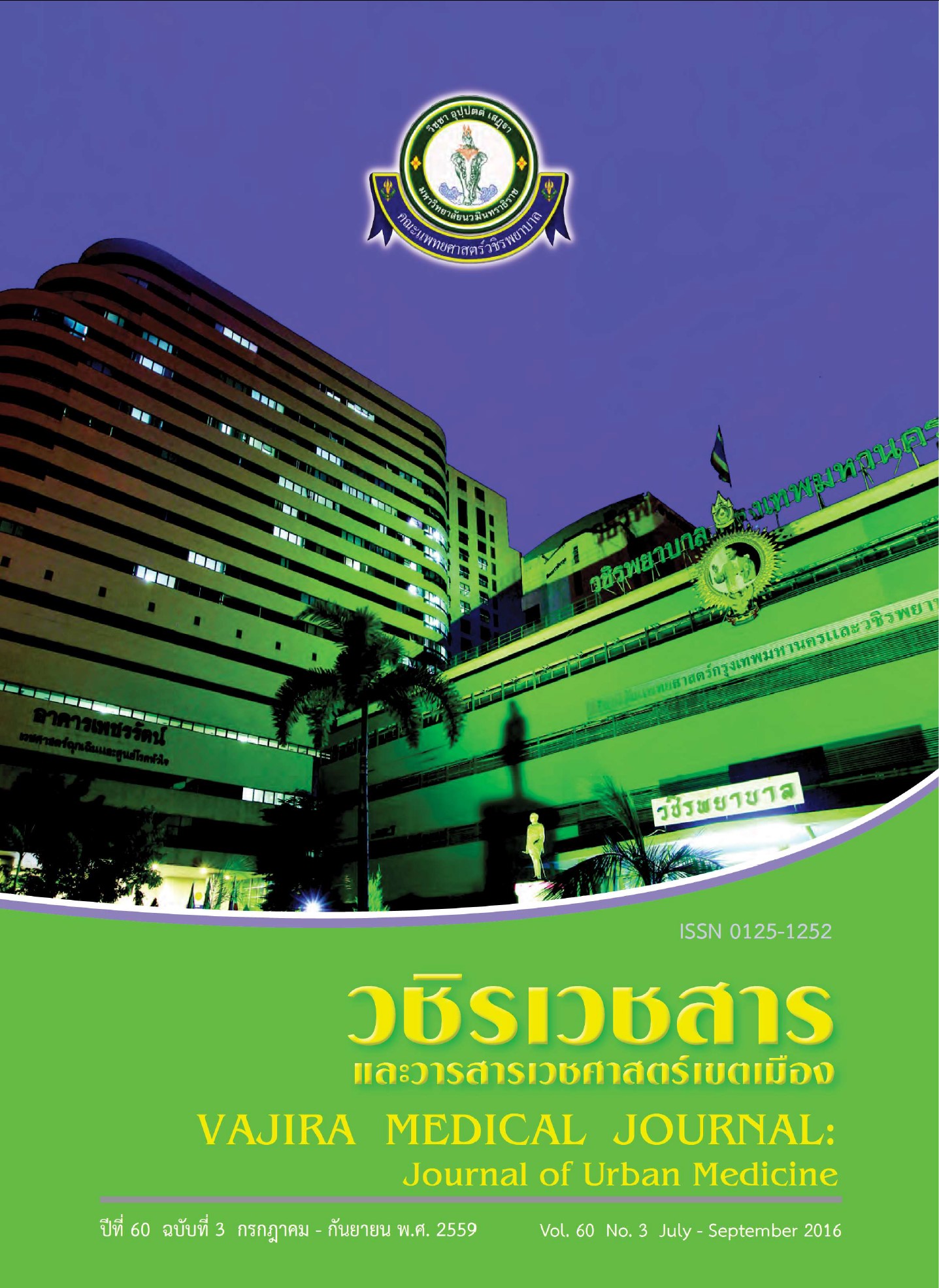Clinical Changing of Children with Autism Assessed by Vajirapattana Tool
Main Article Content
Abstract
Objective: To compare clinical scores of children with autism before and after therapy with Vajirapattana tools and to determine factors related to score changing.
Methods: Retrospective chart review of 32 autistic children aged 18 months to 7 years at child developmental and adolescence unit, Vajira Hospital during January 2012 to October 2014. Individual received Vajirapattana programme that intervened via daily activities with parent-mediated techniques. Wilcoxon signed-rank test was used to compare Vajirapattana score, and Spearman’s rank correlation test to analyses factors correlated with score changing.
Results: There were significant difference of clinical scores in all aspects assessed by Vajirapattana tools before and after therapy (p <0.001). Total behavior score change correlated with sex (rs = -0.476), receiving of speech therapy (rs = -0.387), number of interventions (rs = 0.463) and duration of assessment (rs = 0.442). Family income correlates with score changes on social and total score aspects (rs = -0.383 and rs = -0.358)
Conclusion: Clinical of autistic children were changed. Further, experimental research that adapted Vajirapattana tools according to DSM-5 criteria may useful to improve autistic symptoms.
Downloads
Article Details
References
2. Centers for Disease Control and Prevention. Prevalence of autism spectrum disorders-autism and developmental disabilities monitoring network, 11 sites, United States, 2010. MMWR 2014;63:1-21.
3. National Health Security Office. Ranong hospital, Model of special child developmental care. [Internet]. 2556 [cited 2014 Nov 17]. Available from: https://www.nhso.go.th/frontend/NewsInformationDetail.aspx?newsid=NzMx.
4. Coplan J, Jawad AF. Modeling clinical outcome of children with autistic spectrum disorders. Pediatrics. 2005;116(1):117-22.
5. Landa R, Garrett-Mayer E. Development in infants with autism spectrum disorders: a prospective study. J Child Psychol Psychiatry. 2006;47(6):629-38.
6. Shumway S, Wetherby AM. Communicative acts of children with autism spectrum disorders in the second year of life. J Speech Lang Hear Res. 2009;52(5):1139–56.
7. Barbaro J, Dissanayake C. Developmental profiles of infant and toddlers with autism spectrum disorders identified prospectively in a community-based setting. J Autism Dev Disord. 2012; 42(9):1939-48.
8. Tamaaha AC, Machado GG, Loebmann C, Perissinoto J. Process of speech acquisition and development of autistic children with or without autistic regression. CoDAS. 2014;26(4):265-9. 200 ผลการติดตามอาการทางคลินิกของเด็กออทิสติกด้วยเครื่องมือวชิรพัฒนา ปีที่ 60 ฉบับที่ 3 กรกฎาคม – กันยายน พ.ศ. 2559 วชิรเวชสารและวารสารเวชศาสตร์เขตเมือง ดุษฎี เงินหลั่งทวี
9. Kern JK, Geier DA, Geier MR. Evaluation of regression in autism spectrum disorder based on parental reports. N Am J Med Sci. 2014;6(1):41-7.
10. Gotham K, Pickles A, Lord C. Trajectories of autism severity in children using standardized ADOS scores. Pediatrics. 2012;130(5):e1278-84.
11. Mordre M, Groholt B, Knudsen AK, Sponheim E, Mykletun A, Myhre AM. Is long-term prognosis for pervasive developmental disorder not otherwise specified different from prognosis for autistic disorder? Findings from a 30-year followup study. J Autism Dev Disord. 2012;42:920–8.
12. Anderson DK, Oti RS, Lord C, Welch K. Patterns of growth in adaptive social abilities among children with autism spectrum disorders. J Abnorm Child Psychol. 2009;37(7):1019–34.
13. Joseph L, Thurm A, Farmer C, Shumway S. Repetitive behavior and restricted interests in young children with autism:comparisons with controls and stability over 2 years. Autism Res 2013;6(6):584-95.
14. Richler J, Huerta M, Bishop SL, Lord C. Developmental trajectories of restricted and repetitive behaviors and interests in children with autism spectrum disorders. Dev Psychopathol. 2010;22(1):55–69.
15. Fountain C, Winter AS, Bearman PS. Six developmental trajectories characterize children with autism. Pediatrics. 2012;129:e1112-20.
16. Harrop C, McConachie H, Emsley R, Leadbitter K, Green J. Restricted and repetitive behaviors in autism spectrum disorders and typical development. J Autism Dev Disord. 2014;44(5):1207-19.
17. Muratori F, Narzisi A. Exploratory study describing 6 month outcomes for young children with autism who receive treatment as usual in Italy. Neuropsychiatr Dis Treat. 2014;10:577-86.
18. Drew A, Baird G, Baron-Cohen S, Cox A, Slonims V, Wheelwright S, et al. A pilot randomised control trial of a parent training intervention for pre-school children with autism. Eur Child Adolesc Psychiatry. 2002;11(6):266-72.
19. Green J, Charman T, McConachie H, Aldred C, Slonims V, Howlin P, et al. Parent-mediated communication-focused treatment in children with autism (PACT): a randomised controlled trial. Lancet. 2010;375(9732):2152-60.
20. Oono IP, Honey EJ, McConachie H. Parentmediated early intervention for young children with autism spectrum disorders (ASD). Cochrane Database Syst Rev. 2013;(4):CD009774


